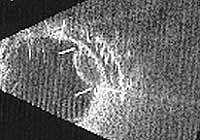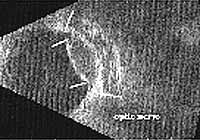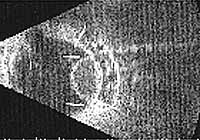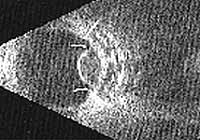Plaque positioning critical for effective uveal melanoma radiation treatment, study shows
Study finds almost 100% success rate with intraoperative echographic localization.
MIAMI — Taking the additional step of using ultrasound in the operating room for verifying the correct positioning of the iodine-125 episcleral plaque when using brachytherapy for the treatment of choroidal melanoma can dramatically enhance the success rate to nearly 100%.
“If the plaque is not perfectly positioned, then the failure rate is significantly increased. We also know that failure is associated with increased mortality,” said Timothy G. Murray, MD, an associate professor of both ophthalmology and radiation oncology at the University of Miami. “This is not rocket science. You’ve got to make sure the radiation is right over the tumor.”
Dr. Murray is co-author of a published study involving 117 eyes with medium-sized choroidal melanoma in 117 patients who did not participate in the Collaborative Ocular Melanoma Study. All current study patients underwent iodine-125 episcleral plaque radiotherapy with intraoperative echographic verification of plaque placement between January 1992 and December 1998 at the Bascom Palmer Eye Institute.
“It is a retrospective study conducted in a prospective fashion, because I have been a believer in using ultrasound in the operating room to localize these plaques since 1991,” Dr. Murray told Ocular Surgery News. In fact, “we treat every tumor patient here with intraoperative localization. So even though the data was retrospectively collected, every patient was prospectively evaluated.”
Standard plaque placement
Satisfactory tumor-plaque apposition was achieved in 76% of study eyes (89 of 177) using standard location techniques, which consisted of transillumination combined with indirect ophthalmoscopy and scleral depression to identify the tumor margins relative to the edge of the plaque. “I thought our success rate would be in this ball park because we treat a lot of tumors that are relatively posterior,” Dr. Murray said. “It turns out that the further back toward the optic nerve and the macula that the tumor is located, the harder it is to use standard techniques. In fact, people have reported failure rates with radiation therapy as high as 25% for tumors that are posteriorly located.” In contrast, “our failure rate was only about 1%.” Therefore, “it was obvious to me that the technique of positioning the plaque was critical for the success rate of the surgery. From a radiation/biology perspective, a significant radiation failure rate does not make sense,” he said.
Among the 28 eyes (24%) that required repositioning of the plaque, the extent of misplacement was less than 1 mm in 10 eyes, 1.1 mm to 3 mm in six eyes, and greater than 3 mm in eight eyes. “If you miss beyond 2 mm, you won’t deliver the radiation to the tumor,” Dr. Murray said. “The plaque is shielded, so if you miss putting the plaque right over the center of the tumor, the radiation doesn’t beam to all of the cancer, so you leave part of the cancer undertreated.”
After repositioning the plaque with the help of ultrasound in the operating room, the success rate was increased to 98.3%. “We had a 100% success rate with echographic localization,” Dr. Murray said. Only two of the 177 patients (1.7%) had local tumor recurrence and underwent enucleation. “That is remarkable because this percentage is very much lower than the previous reported rates, which have ranged from 15% to 25%,” he said.
Excellent imaging
In situations where ocular media were not clear — such as in patients with vitreous hemorrhage — echography provided excellent imaging of the tumor-plaque relationship. “This allowed us to treat patients with plaque whom we may not have normally been able to treat because of bleeding,” Dr. Murray said. Furthermore, ultrasound permitted the detection of tilted plaques that otherwise may not have been detected. “If a plaque tilts away from the eye, all the standard techniques can’t see that. But the ultrasound lets you see whether the plaque is flat against the sclera or is pushed away.”
On the other hand, anterior tumors are difficult to localize using ultrasound, “but are not difficult to localize using standard techniques,” Dr. Murray said. Not surprisingly, therefore, anterior tumors had a 92% success rate. Repositioning was necessary in only one of the 13 eyes with an anteriorly located tumor. Conversely, 20 of 67 eyes with peripapillary or posterior pole tumors required repositioning.
“I believe the reason that previous failure rates have been reported to be so high is because we’ve all intuitively thought that positioning is an easy thing to do — but it’s not,” Dr. Murray said.
 Longitudinal section of initial placement shows the plaque decentered anteriorly with alignment of the posterior tumor margin and posterior border of the plaque. |
 Longitudinal section of final placement shows good anterior and posterior margin coverage with the plaque abutting the optic nerve. |
 Transverse section shows plaque decentered nasally. The arrows show tumor margins, and the bars show the plaque borders. |
 Transverse section at final placement shows good centration. |
For Your Information:Reference:
- Timothy G. Murray, MD, can be reached at Bascom Palmer Eye Institute, 900 N.W. 17th St., Miami, FL 33136 U.S.A.; +(1) 305-326-6166; fax: +(1) 305-326-6417; e-mail: tmurray@bpei.med.miami.edu.
- Tabandeh H, Chaudhry NA, Murray TG, et al. Intraoperative echographic localization of iodine-125 episcleral plaque for brachytherapy of choroidal melanoma. Am J Ophthalmol. 2000;129:199-204.
